Hamster Talk!
Welcome to the world of Hamster Talk! Where everything is dedicated to all the hamsters of the world! Rather you currently have a furry friend, used to have one, are thinking of adopting one, or just like to know your facts, this is the place for you!
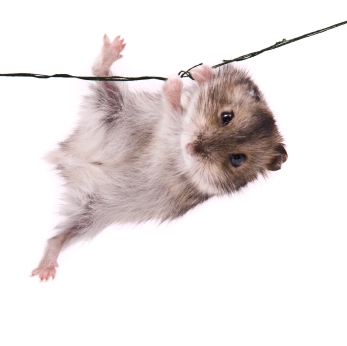
Hamster Species
There are many species of hamsters but only five species are widely kept in captivity as pets in the United States. Here I will list them and give some information on each.
Syrian Hamster
Scientific Name: Mesocricetus auratus
Alternative Names: Golden Hamster, Fancy Hamster,
Teddybear Hamster, Standard Hamster
Native To: Syria
Adult Size: 5-6"
Life Span: 2-3 years
About: Syrian Hamsters are the most well known hamsters and are most often kept as pets. They are excellent starter hamsters. Syrian hams do NOT get along with other hamsters though and will fight once they are a few months old, so they are best kept alone. Syrian hamsters have developed a variety of colors and pattern mutations, including cream, white, blonde, cinnamon, tortoiseshell, black, three different shades of gray, dominant spot, banded and dilute. Syrian hamsters also have a long haired form known as "angora".
Dwarf Russian Djungarian Hamster
Scientific Name: Phodopus sungorus
Alternative Names: Winter White Hamster, Siberian Hamster
Native To: Asia
Adult Size: 3-5"
Life Span: 1-2 years
About: Djungarian hamsters are thought to be one of the most naturally tame species of hamster. Due to their friendly nature, they can often be housed with another hamster of the same species, though there is still a chance they may fight. They typically have a thick, dark grey dorsal stripe, but there are other color variations such as pearl and sapphire. Their feet are covered in fur to protect them from the cold. As winter approaches and the days shorten, the Djungarian hamster's dark fur is just about entirely replaced with white fur. In captivity this almost never happens, though.
Roborovski Hamster
Scientific Name: Phodopus roborovskii
Alternative Names: Robos, Robs, Dessert Hamsters
Native To: Asia
Adult Size: 1.5-3"
Life Span: 2-3 years
About: Roborovski Hamsters are the smallest of all hamsters. They are very fast and active, thus making them a challenge to tame. They have been said to run the equivalent of four human marathons per night on average. They can be housed together if they are introduced at an early age, but they are also very territorial so owners need to be aware of this. Robos are known for their distinguishing eyebrow-like spots over their eyes, and are typically a sandy color with white on their bellies.
Dwarf Cambells Russian Hamster
Scientific Name: Phodopus campbelli
Alternative Names:Cam
Native To: Asia, China
Adult Size: 2-3"
Life Span: 2-3 years
About: Cambell Hamsters are closely related to Djungarian Hamsters. Campbell's can live happily together if they are introduced at an early age, however, hamsters that have been housed together for some time can occasionally end up fighting to the point that they need to be separated. They can be many different colors and have one of four coat types; normal, satin, wavy or rex.
Dwarf Chinese Hamster
Scientific Name: Cricetulus griseus
Alternative Names:
Native To: Asia, China
Adult Size: 4"
Life Span: 3-5 years
About:When young, Chinese Dwarf Hamsters are quite nervous but grow to be very gentle and calm. Compared with other hamsters they have a long, thin build and a relatively long tail. They can be greyish/brown in color with a dark stripe down their spine and a light colored underside. Some US states such as California, regard Chinese Hamsters as pests and a special permit is required to own, breed and sell them. In other states such as New Jersey they are classed as exotic animals and a permit is also required to own them.
There are many species of hamsters but only five species are widely kept in captivity as pets in the United States. Here I will list them and give some information on each.
Syrian Hamster
Scientific Name: Mesocricetus auratus
Alternative Names: Golden Hamster, Fancy Hamster,
Teddybear Hamster, Standard Hamster
Native To: Syria
Adult Size: 5-6"
Life Span: 2-3 years
About: Syrian Hamsters are the most well known hamsters and are most often kept as pets. They are excellent starter hamsters. Syrian hams do NOT get along with other hamsters though and will fight once they are a few months old, so they are best kept alone. Syrian hamsters have developed a variety of colors and pattern mutations, including cream, white, blonde, cinnamon, tortoiseshell, black, three different shades of gray, dominant spot, banded and dilute. Syrian hamsters also have a long haired form known as "angora".
Dwarf Russian Djungarian Hamster
Scientific Name: Phodopus sungorus
Alternative Names: Winter White Hamster, Siberian Hamster
Native To: Asia
Adult Size: 3-5"
Life Span: 1-2 years
About: Djungarian hamsters are thought to be one of the most naturally tame species of hamster. Due to their friendly nature, they can often be housed with another hamster of the same species, though there is still a chance they may fight. They typically have a thick, dark grey dorsal stripe, but there are other color variations such as pearl and sapphire. Their feet are covered in fur to protect them from the cold. As winter approaches and the days shorten, the Djungarian hamster's dark fur is just about entirely replaced with white fur. In captivity this almost never happens, though.
Roborovski Hamster
Scientific Name: Phodopus roborovskii
Alternative Names: Robos, Robs, Dessert Hamsters
Native To: Asia
Adult Size: 1.5-3"
Life Span: 2-3 years
About: Roborovski Hamsters are the smallest of all hamsters. They are very fast and active, thus making them a challenge to tame. They have been said to run the equivalent of four human marathons per night on average. They can be housed together if they are introduced at an early age, but they are also very territorial so owners need to be aware of this. Robos are known for their distinguishing eyebrow-like spots over their eyes, and are typically a sandy color with white on their bellies.
Dwarf Cambells Russian Hamster
Scientific Name: Phodopus campbelli
Alternative Names:Cam
Native To: Asia, China
Adult Size: 2-3"
Life Span: 2-3 years
About: Cambell Hamsters are closely related to Djungarian Hamsters. Campbell's can live happily together if they are introduced at an early age, however, hamsters that have been housed together for some time can occasionally end up fighting to the point that they need to be separated. They can be many different colors and have one of four coat types; normal, satin, wavy or rex.
Dwarf Chinese Hamster
Scientific Name: Cricetulus griseus
Alternative Names:
Native To: Asia, China
Adult Size: 4"
Life Span: 3-5 years
About:When young, Chinese Dwarf Hamsters are quite nervous but grow to be very gentle and calm. Compared with other hamsters they have a long, thin build and a relatively long tail. They can be greyish/brown in color with a dark stripe down their spine and a light colored underside. Some US states such as California, regard Chinese Hamsters as pests and a special permit is required to own, breed and sell them. In other states such as New Jersey they are classed as exotic animals and a permit is also required to own them.
Other species of hamsters that are not widely kept as pets are:
European Hamster
Common Hamster
Black Bellied Hamster
Rumanian Hamster
Romanian Hamster
Turkish Hamster
Brandts' Hamster
Ciscaucasian Hamster
Georgian Hamster
Ladak Hamster
Chinese Striped Hamster
Mongolian Hamster
Eversmann's Hamster
Tibetan Hamster
Lesser Longtailed Hamster
Armenian Hamster
Migratory Grey Hamster
Greater Longtailed Hamster
Korean Hamster
Mouse-Like Hamster
European Hamster
Common Hamster
Black Bellied Hamster
Rumanian Hamster
Romanian Hamster
Turkish Hamster
Brandts' Hamster
Ciscaucasian Hamster
Georgian Hamster
Ladak Hamster
Chinese Striped Hamster
Mongolian Hamster
Eversmann's Hamster
Tibetan Hamster
Lesser Longtailed Hamster
Armenian Hamster
Migratory Grey Hamster
Greater Longtailed Hamster
Korean Hamster
Mouse-Like Hamster
Hamsters
Hamsters are rodents belonging to the subfamily Cricetinae. Hamsters are crepuscular (meaning they are most active during dawn and dusk) animals which burrow underground in the daylight to avoid being caught by predators. Their diets include a variety of foods, including dried food, berries, nuts, fresh fruits and vegetables. In the wild, they feed primarily on seeds, fruits and greens, and will occasionally eat burrowing insects. They have an elongated pouch on each side of their heads that extends to their shoulders, which they stuff full of food to be stored, brought back to the colony or to be eaten later.
Hamster behavior varies depending on their environment, genetics, and interaction with people. Hamsters have also become established as popular small house pets, and are sometimes accepted even in areas where other rodents are disliked.
Hamsters are rodents belonging to the subfamily Cricetinae. Hamsters are crepuscular (meaning they are most active during dawn and dusk) animals which burrow underground in the daylight to avoid being caught by predators. Their diets include a variety of foods, including dried food, berries, nuts, fresh fruits and vegetables. In the wild, they feed primarily on seeds, fruits and greens, and will occasionally eat burrowing insects. They have an elongated pouch on each side of their heads that extends to their shoulders, which they stuff full of food to be stored, brought back to the colony or to be eaten later.
Hamster behavior varies depending on their environment, genetics, and interaction with people. Hamsters have also become established as popular small house pets, and are sometimes accepted even in areas where other rodents are disliked.
Hamster Hybrids
The offspring produced from the mating of two separate species are known as hybrids. Of the 5 species widely kept as pets only two species can interbreed and produce live offspring. These are Campbell's Hamsters and Winter White (Djungarian) Hamsters. The hybrids are commonly referred to as "Pudding Hamsters" due to their unique coloring. Pudding Hamsters are a peach color and have an orange dorsal stripe. They are a rather rare find because breeders of Pudding Hamsters must be very skilled to produce healthy hams. It is not recommended that hamster owners try to breed them for this reason. Pudding Hamsters are still a rather new species, and there is not much known about them yet.
The offspring produced from the mating of two separate species are known as hybrids. Of the 5 species widely kept as pets only two species can interbreed and produce live offspring. These are Campbell's Hamsters and Winter White (Djungarian) Hamsters. The hybrids are commonly referred to as "Pudding Hamsters" due to their unique coloring. Pudding Hamsters are a peach color and have an orange dorsal stripe. They are a rather rare find because breeders of Pudding Hamsters must be very skilled to produce healthy hams. It is not recommended that hamster owners try to breed them for this reason. Pudding Hamsters are still a rather new species, and there is not much known about them yet.
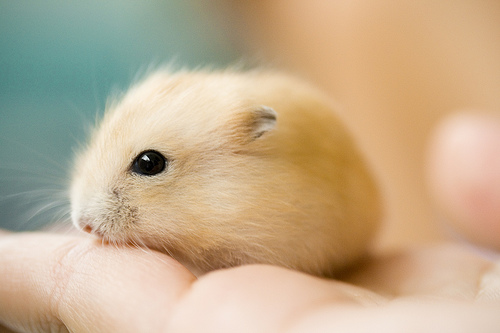
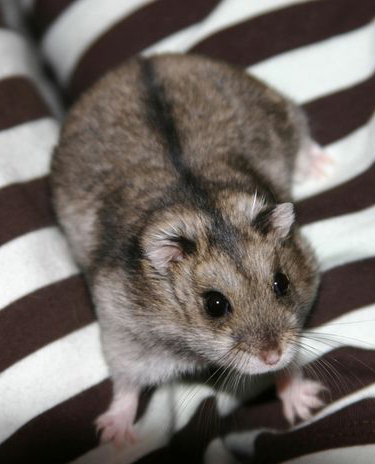
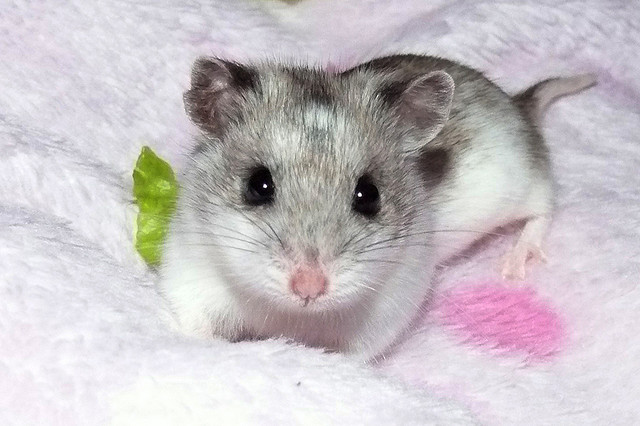
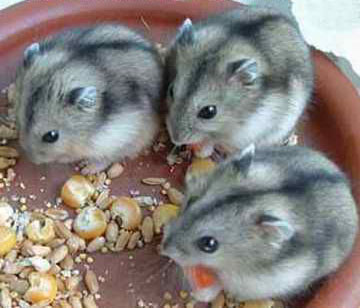
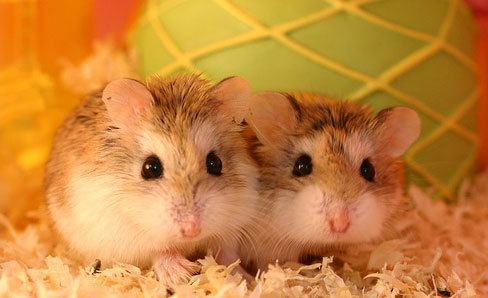
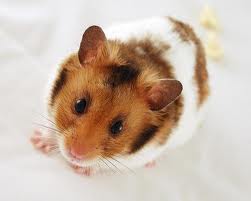
Ham Facts!
-Hamsters can remember their relatives.
-Hamsters are trainable and can be taught how to come by name.
-Hamsters' teeth never stop growing.
-Female dwarf hamsters can give birth as young as five weeks. This is not recommended though. You should wait until she is at least 3 months old.
-Campbell's dwarf hamsters are a very new breed. They weren't widely sold as pets until around 1995.
-Hamsters are short sighted and color blind.
-Hamsters are omnivores, this means they eat both vegetables and meat.
-Hamsters store and carry food in their spacious cheek pouches.
-Hamsters name means “to hoard” in German.
-A human year is about 25 hamster years.
-A Male hamster is called a boar.
-A Female hamster is called a sow.
-Baby hamsters are called pups.
-Hamsters can carry half their body weight in their cheek pouches.
-Some hamsters can share a cage, some hamsters can’t. Syrian hamsters must never be caged together once they reach 5 weeks of age, as they are territorial and will fight, sometimes to the death of one or both. If you want two or more Syrian hamsters, get a spacious cage for each one. Dwarf hamsters can often share a cage if they’re introduced to their future cagemates at an early age. If serious fighting occurs among the hamsters, however, the combatants must be placed in separate cages. NOTE: cage mates must have their own wheel and house.
-Hamsters can remember their relatives.
-Hamsters are trainable and can be taught how to come by name.
-Hamsters' teeth never stop growing.
-Female dwarf hamsters can give birth as young as five weeks. This is not recommended though. You should wait until she is at least 3 months old.
-Campbell's dwarf hamsters are a very new breed. They weren't widely sold as pets until around 1995.
-Hamsters are short sighted and color blind.
-Hamsters are omnivores, this means they eat both vegetables and meat.
-Hamsters store and carry food in their spacious cheek pouches.
-Hamsters name means “to hoard” in German.
-A human year is about 25 hamster years.
-A Male hamster is called a boar.
-A Female hamster is called a sow.
-Baby hamsters are called pups.
-Hamsters can carry half their body weight in their cheek pouches.
-Some hamsters can share a cage, some hamsters can’t. Syrian hamsters must never be caged together once they reach 5 weeks of age, as they are territorial and will fight, sometimes to the death of one or both. If you want two or more Syrian hamsters, get a spacious cage for each one. Dwarf hamsters can often share a cage if they’re introduced to their future cagemates at an early age. If serious fighting occurs among the hamsters, however, the combatants must be placed in separate cages. NOTE: cage mates must have their own wheel and house.